The Basics you Must Master Before Diving into Marketing & Product Analytics
Things that still confuse many Data AnalystsRecently, I gave a presentation on a specific topic: how to investigate drop-offs in conversion funnels within the context of marketing and product analysis.What surprised me? The incredible engagement from the audience. The questions were varied and not just from Data Analysts. Even Data Engineers were curious about how the data they collect is used to make strategic decisions.A question that often comes up…“Is what you do like Google Analytics?”It’s probably the most frequent question I get. And for those who know a bit more, they say:“Oh, so it’s about improving conversion rates and user experience?Not wrong. But the reality is much broader… and far more exciting!In this edition, I’ll share everything I know about these two fascinating niches of data analysis:Marketing Analytics and Product Analytics, and most importantly, the key differences between them.What’s on the agenda:What are Product Analytics and Marketing Analytics?The main differences:a. Objectivesb. Teams involvedc. Toolsd. KPIsConclusion1. What are Marketing Analytics and Product Analytics?Product Analytics is the discipline of collecting, measuring, and analyzing data about how users interact with your product.A concrete example: You work for a fitness app and want to answer questions like:How much time do users spend on a workout session?Do they complete their first fitness plan, or drop out halfway?Why do 30% of users quit after the second week?By analyzing the data, you notice many users drop off at the goal-setting screen. Why? The interface is too complicated.With this insight, you collaborate with the Product team to simplify the screen, and completion rates increase by 20%. That’s the direct impact of Product Analytics: turning insights into actionable results.Marketing Analytics, on the other hand, focuses on acquiring new users. Sticking with the fitness app example, you aim to answer questions like:Which ad (Facebook, Google Ads, etc.) generates the most clicks?Which channel brings users who stay subscribed for more than three months?How much does each download from an Instagram campaign cost?A key insight? You discover TikTok ads generate a lot of traffic, but most users uninstall the app after three days. Conversely, users coming from sponsored articles on a fitness blog remain subscribed much longer.What do you do? You adjust your budget to prioritize sponsored content, maximizing the return on investment (ROI) of your campaigns.Visual comparison of Product Analytics and Marketing Analytics2. Key Differences:a. ObjectivesAs you’ve seen, Product Analytics and Marketing Analytics share a common goal: helping businesses make data-driven decisions to drive growth. But despite their close connection, these two disciplines have very different focuses.Product Analytics aims to improve the product experience, eliminate friction points, and boost retention.Marketing Analytics focuses on optimizing acquisition campaigns, increasing ROI, and reducing customer acquisition costs (CAC).The fundamental difference lies in the stage of the customer journey they focus on:Product Analytics is about the user journey, from the moment they first open the product to their eventual cancellation.Marketing Analytics focuses on how users discover your product and what drives them to become customers.In practice, these two stages are often interconnected. Imagine a meditation app offering a 7-day free trial. The marketing team uses Instagram ads to attract new users. Once inside the app, users interact with the product. Even though they’re not paying customers yet, Product Analytics comes into play to understand which behaviors during the trial best predict conversion to a paying customer. This example shows that the boundaries between Product Analytics and Marketing Analytics can blur, with the two disciplines complementing each other.Where Marketing Analytics and Product Analytics come in on a user journeyb. Teams Involved: Who Does What?As a Data Analyst, your collaborators vary depending on the discipline. Whether you work on Product Analytics or Marketing Analytics, your role is to bridge the gap between data and teams, helping them make informed decisions.For Product Analytics:Product Managers (PMs): Use your insights to prioritize developments and measure the impact of new features.Developers: Ensure proper tracking implementation for solid future analyses.UX Designers: Identify and resolve friction points to make interfaces more intuitive.For Marketing Analytics:Growth Marketers: Help identify the best-performing audience segments for acquisition campaigns.Acquisition Managers: Analyze underperforming campaigns and recommend adjustments.Social Media Managers: Provide data-driven strategies by analyzing trends.Despite their distinct goals and responsibilities, Product and Marketing teams work hand in hand. Data is their shared language.For example:Product feeds Marketing: If TikTok users disengage quickl
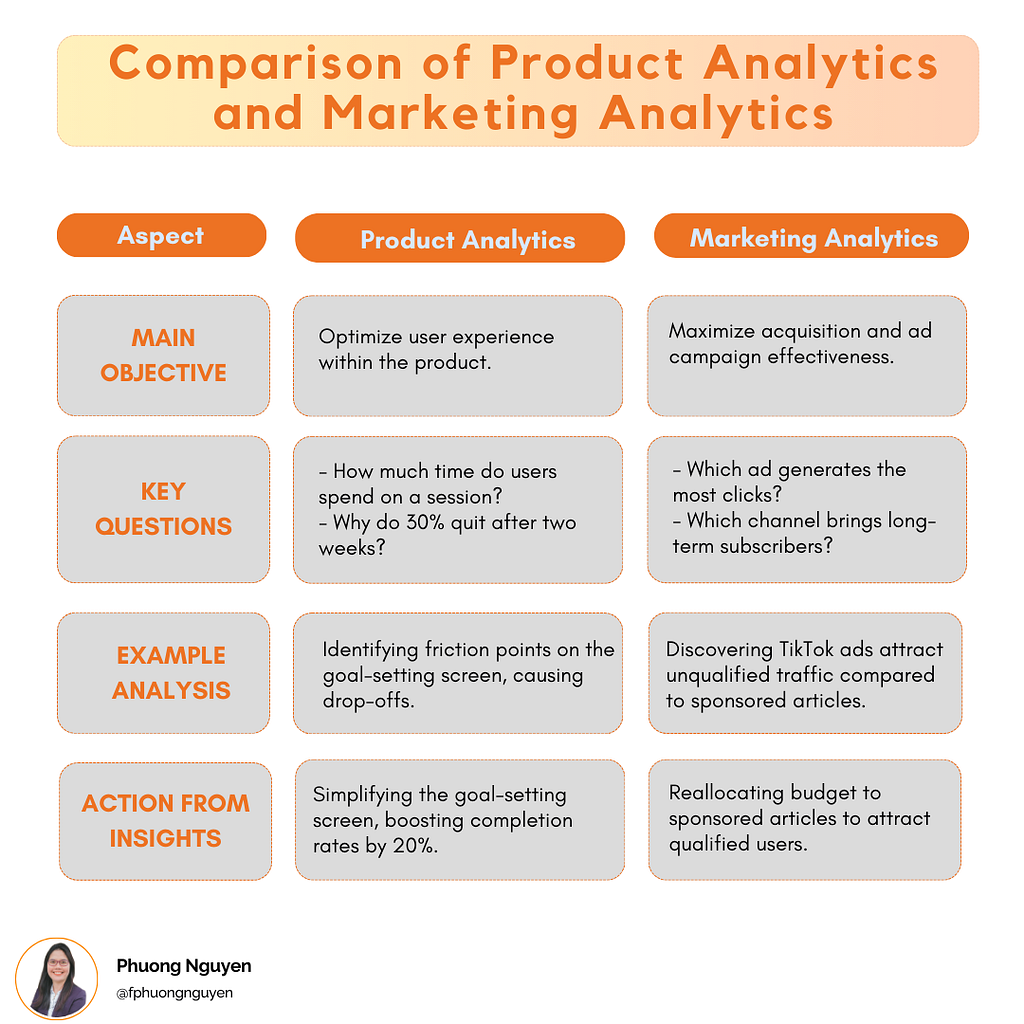
Things that still confuse many Data Analysts
Recently, I gave a presentation on a specific topic: how to investigate drop-offs in conversion funnels within the context of marketing and product analysis.
What surprised me? The incredible engagement from the audience. The questions were varied and not just from Data Analysts. Even Data Engineers were curious about how the data they collect is used to make strategic decisions.
A question that often comes up…
“Is what you do like Google Analytics?”
It’s probably the most frequent question I get. And for those who know a bit more, they say:
“Oh, so it’s about improving conversion rates and user experience?
Not wrong. But the reality is much broader… and far more exciting!
In this edition, I’ll share everything I know about these two fascinating niches of data analysis:
Marketing Analytics and Product Analytics, and most importantly, the key differences between them.
What’s on the agenda:
- What are Product Analytics and Marketing Analytics?
- The main differences:
a. Objectives
b. Teams involved
c. Tools
d. KPIs - Conclusion
1. What are Marketing Analytics and Product Analytics?
Product Analytics is the discipline of collecting, measuring, and analyzing data about how users interact with your product.
A concrete example: You work for a fitness app and want to answer questions like:
- How much time do users spend on a workout session?
- Do they complete their first fitness plan, or drop out halfway?
- Why do 30% of users quit after the second week?
By analyzing the data, you notice many users drop off at the goal-setting screen. Why? The interface is too complicated.
With this insight, you collaborate with the Product team to simplify the screen, and completion rates increase by 20%. That’s the direct impact of Product Analytics: turning insights into actionable results.
Marketing Analytics, on the other hand, focuses on acquiring new users. Sticking with the fitness app example, you aim to answer questions like:
- Which ad (Facebook, Google Ads, etc.) generates the most clicks?
- Which channel brings users who stay subscribed for more than three months?
- How much does each download from an Instagram campaign cost?
A key insight? You discover TikTok ads generate a lot of traffic, but most users uninstall the app after three days. Conversely, users coming from sponsored articles on a fitness blog remain subscribed much longer.
What do you do? You adjust your budget to prioritize sponsored content, maximizing the return on investment (ROI) of your campaigns.
2. Key Differences:
a. Objectives
As you’ve seen, Product Analytics and Marketing Analytics share a common goal: helping businesses make data-driven decisions to drive growth. But despite their close connection, these two disciplines have very different focuses.
- Product Analytics aims to improve the product experience, eliminate friction points, and boost retention.
- Marketing Analytics focuses on optimizing acquisition campaigns, increasing ROI, and reducing customer acquisition costs (CAC).
The fundamental difference lies in the stage of the customer journey they focus on:
- Product Analytics is about the user journey, from the moment they first open the product to their eventual cancellation.
- Marketing Analytics focuses on how users discover your product and what drives them to become customers.
In practice, these two stages are often interconnected. Imagine a meditation app offering a 7-day free trial. The marketing team uses Instagram ads to attract new users. Once inside the app, users interact with the product. Even though they’re not paying customers yet, Product Analytics comes into play to understand which behaviors during the trial best predict conversion to a paying customer. This example shows that the boundaries between Product Analytics and Marketing Analytics can blur, with the two disciplines complementing each other.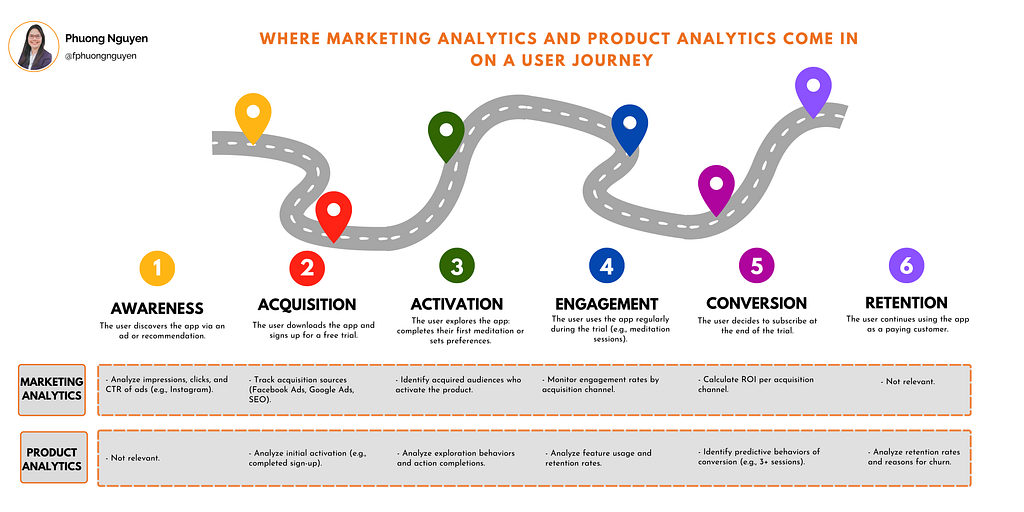
b. Teams Involved: Who Does What?
As a Data Analyst, your collaborators vary depending on the discipline. Whether you work on Product Analytics or Marketing Analytics, your role is to bridge the gap between data and teams, helping them make informed decisions.
For Product Analytics:
- Product Managers (PMs): Use your insights to prioritize developments and measure the impact of new features.
- Developers: Ensure proper tracking implementation for solid future analyses.
- UX Designers: Identify and resolve friction points to make interfaces more intuitive.
For Marketing Analytics:
- Growth Marketers: Help identify the best-performing audience segments for acquisition campaigns.
- Acquisition Managers: Analyze underperforming campaigns and recommend adjustments.
- Social Media Managers: Provide data-driven strategies by analyzing trends.
Despite their distinct goals and responsibilities, Product and Marketing teams work hand in hand. Data is their shared language.
For example:
- Product feeds Marketing: If TikTok users disengage quickly, Product and Growth Marketers can adjust both acquisition strategies and onboarding experiences.
- Marketing enlightens Product: If a campaign highlights a specific feature, the Product team ensures this promise is easily discoverable from day one.
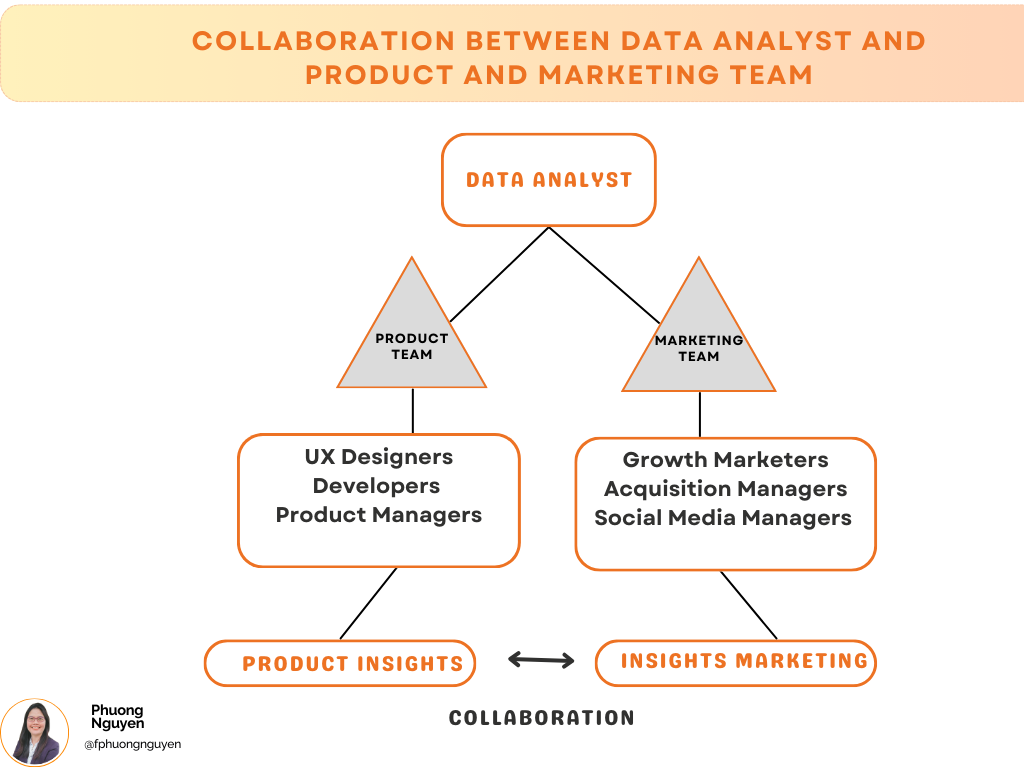
c. Tools
Tools are a key difference between Product Analytics and Marketing Analytics.
The tools used in Product Analytics, such as Mixpanel and Amplitude, are designed to collect and track user interactions with the product.
What can you do with these tools?
- Build user journeys: Identify the steps where your users drop off and find solutions to retain them.
- Track events in real time: For example, observe how many clicks a new feature has generated since its launch.
The tools used in Marketing Analytics, such as Google Analytics, Meta Ad Manager, and HubSpot, are designed to analyze campaigns and the performance of acquisition channels.
What can you do with these tools?
- Analyze traffic sources: Are your visitors coming primarily from SEO, paid ads, or social media?
- Track campaign ROI: Which ad performs best?
- Optimize targeting: Identify the most relevant audiences to maximize your results.
A key point to note: the granularity of data
- Product Analytics allows you to analyze interactions at the individual user level. For example, you can see which screens a specific user visited during their sessions.
- Marketing Analytics, on the other hand, relies on aggregated data. For example, you know that 2,512 users came through a Facebook campaign, but not their individual identities.
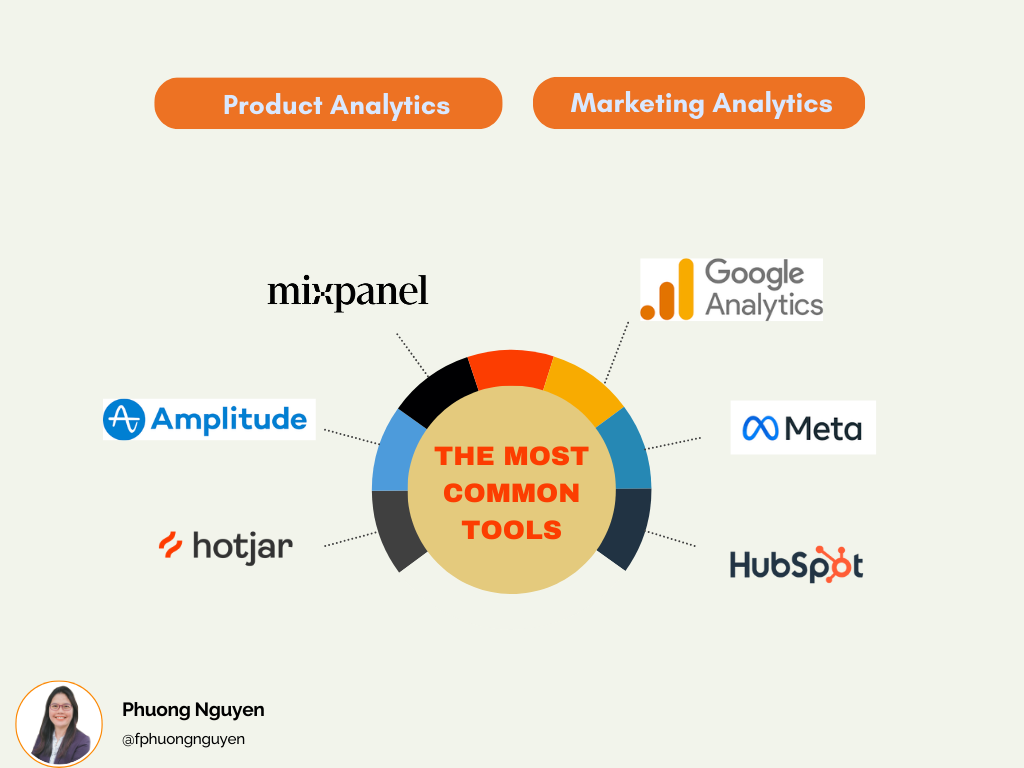
d. KPIs
KPIs, those famous key performance indicators, are at the heart of every data analysis project. However, their interpretation can vary significantly depending on whether you’re talking about Product Analytics or Marketing Analytics.
Let’s take a simple example: the conversion rate.
- In Product Analytics, it might refer to the percentage of users who activate a new feature.
- In Marketing Analytics, it’s often the percentage of visitors who become customers after clicking on an ad.
Same name, completely different context.
KPIs in Product Analytics aim to evaluate how users interact with the product and identify opportunities to improve their experience. Here are some key metrics:
- Feature usage: What proportion of users are using a specific feature?
- Feature adoption rate: How many users adopt a new feature over a given period?
- Activation rate: The percentage of users who complete a key action after signing up (e.g., listening to a song on Spotify).
- Churn rate: The rate at which users abandon the product over a given period.
- Retention rate: The percentage of users who return to the product after their first interaction.
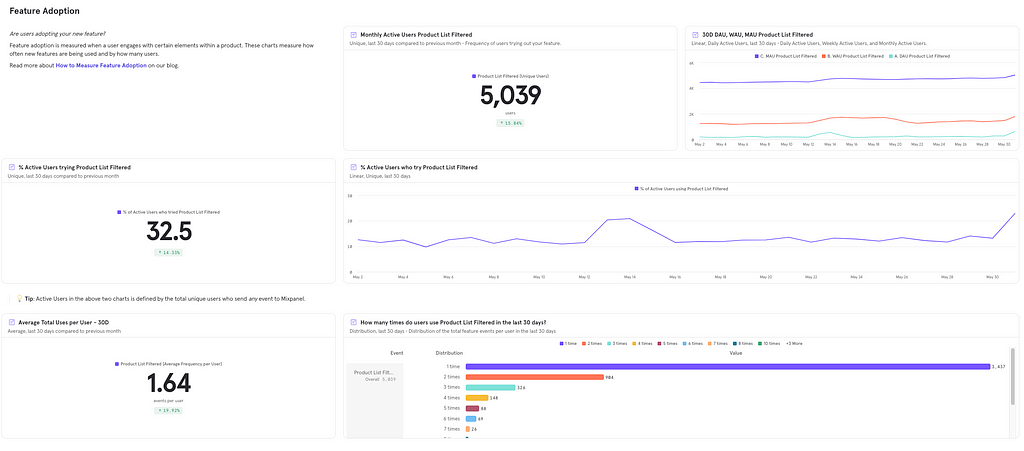
In Marketing Analytics, KPIs measure the performance of acquisition campaigns and the quality of the generated traffic. The objectives are to attract qualified users and maximize ROI. Here are some examples:
- Click-through rate (CTR): The percentage of clicks relative to the impressions of an ad campaign.
- Conversion rate: The percentage of visitors who complete a target action (e.g., sign-up, purchase).
- Customer Acquisition Cost (CAC): The total cost to acquire a new user.
- Return on Investment (ROI): The profit generated in relation to the cost of marketing campaigns.
- Traffic source performance: Analyzing the channels (SEO, social media, ads) that bring in the most qualified traffic.
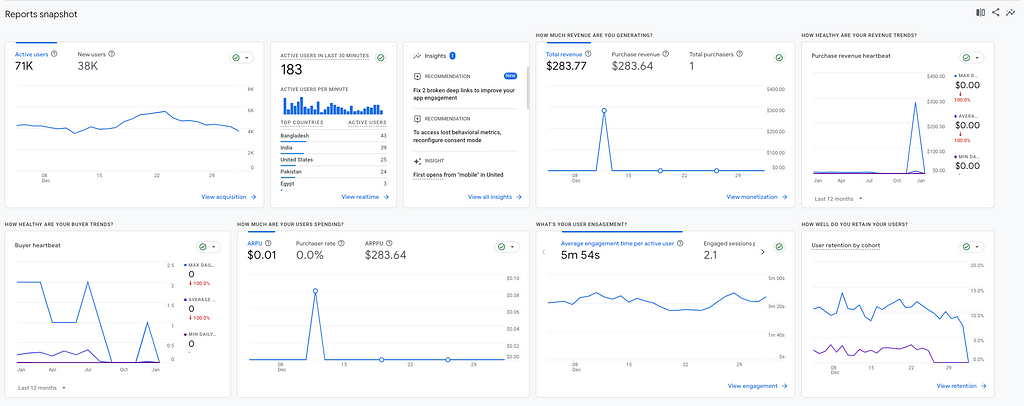
Conclusion
In some companies, roles are well-defined. A Data Analyst may focus exclusively on the Product side or, conversely, solely on the Marketing side (sometimes referred to as Growth).
Some organizations draw a clear line. Up until user activation (e.g., completing a key action in the product), it falls under the scope of Growth or Marketing Analytics. After activation, the Product team takes over.
In other companies, particularly smaller ones, this boundary is blurred or even nonexistent. A Data Analyst may handle all analyses, whether related to Product or Marketing.
Despite these variations, one thing is certain: with the digital transformation of businesses, the demand for data analysis will only continue to grow. More and more digital products are emerging, and behind each product lies a wealth of data to explore and transform into insights.
Our profession as Data Analysts has a bright future ahead.
What's Your Reaction?







































